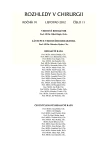The value of intraoperative ultrasonography in parathyroid surgery
Authors:
M. Linhartová 1; L. Mitáš 1; K. Starý 2; H. Munteanu 1
Authors‘ workplace:
Chirurgická klinika, FN Brno a LF MU Brno, přednosta: Prof. MUDr. Z. Kala, Ph. D.
1; Interní gastroenterologická klinika, FN Brno a LF MU Brno, přednosta: Prof. MUDr. A. Hep, CSc.
2
Published in:
Rozhl. Chir., 2012, roč. 91, č. 11, s. 614-619.
Category:
Original articles
Overview
Introduction:
Ultrasound of the neck is a sovereign complementary imaging method suitable for determining morphological changes in thyroidology which uses the so-called B-mode two-dimensional images for the neck area that are complemented by duplex Doppler imaging. Diagnostic verification is performed by sonographists from among radiologists and endocrinologists providing regular outpatient care; the surgeon uses ultrasound for navigation to attain the focus to be operated on.
Sonography will provide information on the structure of the thyroid, of the parathyroids, their relationship to the surrounding organs (location, size, relationship to breathing and swallowing pathways). We search for the presence of any pathological abnormalities such as the affection of other organs, tumour invasion into surrounding tissue; it is also important to assess the size and nature of the cervical lymph nodes pretracheally, prelaryngeally, paratracheally, along the vascular plexus and supraclavicularly, where thyroid tumours may form metastases. USG assessment of the regional lymph nodes should not be forgotten before surgical management of thyroid nodules or the parathyroids. Thanks to the introduction of ultrasound as an additional screening method in parathyroid surgery we have gained the opportunity of more precise and successful localisation of pathological parathyroid lesions, which is beneficial for patients with hyperparathyroidism.
Material and methods:
We worked with a group of patients from 2002 to 2010 when we selected 370 prospectively followed patients operated on for endocrine disease of the thyroid and parathyroid glands. The group consisted of 77 men and 293 women. This group was further selected according to the required criteria specified in the text. Since we are focusing on peroperative ultrasound and on the detection and specification of the position of the parathyroid glands for the surgeon, we are concentrating chiefly on pathological parathyroid glands. These are imaged as circumscribed hypoechoic lesions with hyperechoic margin.
Ultrasonography is considered both a sovereign standard diagnostic method and a very valuable navigational method used to localise pathological glands. We use a linear as well as a special “hockey stick” probe which has a higher resolution.
Results:
For comparison, both detection methods – gamma navigation and ultrasound – are dealt with. We are fully aware of the small number of patients in the selected groups. The results of the statistical analysis show that the use of ultrasound and gamma navigation shortens the overall operation time. More interesting, however, is the indicator of the range of variation, i.e. the difference between the maximum and minimum length of operation. When using one or the other detection method, the variation range is significantly lower and it is apparent that using the gamma-ray or ultrasound navigation system, the detection of the parathyroid gland, particularly when unusually located, is much simpler and thus faster. This finding is also supported by an additional parameter, variance, which expresses the variability of the distribution of values – around the average length of operation.
Conclusion:
Preoperative and intraoperative detection of hyperactive parathyroid glands is useful for minimizing the extent of surgical intervention, reducing operation time and decreasing the risk of perioperative complications. It is not necessary to use a radionuclide and therefore the method can be used even where there is no nuclear medicine station. It is also possible to detect glands which do not accumulate radionuclides and thus cannot be imaged with MIBI scintigraphy/SPECT CT. Still, an experienced surgeon remains irreplaceable. We dare say that if such a surgeon can make use of the abovementioned auxiliary methods in addition, the rate of success in this field of surgery increases substantially.
Keywords:
ultrasound – navigation during surgery – localisation – reducing operation time
Sources
1. Kraimps JL, Barbier J. Contribution of peroperative ultrasonography. Ann Endocrinol (Paris) 1993;54(4):235–6.
2. Libánský P, Broulík P, Křížová H at al. Význam předoperačních a peroperačních lokalizačních vyšetření u primární hyperparatyreózy. DMEV 2006;2 : 85–89.
3. Jiskra J. Struma a tyreoidální uzly. Review, Euni.cz XII/09.
4. Jiskra J. Racionální diagnostika a léčba nemocí štítné žlázy. Med Pro Praxi 2010;7(4): 167–172.
5. Stárka L, Zamrazil V. Základy klinické endokrinologie. MAXDORF 1997,2005 : 81–14,ISBN 80-7345-066-6.
6. Tarantino L, Francica G, Sordelli I, Sperlongano P, Parmeggiani D, Ripa C. Parmeggiani U. Percutaneous Ethanol Injection of Hyperfunctioning Thyroid Nodules: Long-Term Follow-Up in 125 Patients. American J of Roentg 2008;190 : 800–808.
7. Dossing H, Bennedbaek F, Karstrup S, Hegedüs L. Benign Solitary Solid Cold Thyroid Nodules: US-guided Interstitial Laser Photocoagulation — Initial Experience. Radiology 2010;(10)225 : 53–57.
8. Baek et al. Benign Predominantly Solid Thyroid Nodules: Prospective Study of Efficacy of Sonographically Guided Radiofrequency Ablation Versus Control Condition. Am J Roentgenol 2010;194 : 1137–1142.
9. Silverberg S J, Brown I, Bilezikian J P. Youth fulness as a criterion for surgery in primary hyperparathyroidism. Am J Med 2002; 113 : 681–684.
10. Adámek S, Naňka O. Primární hyperparatyreóza, operativní řešení. Praha, Galén 2006 : 202.
11. Andersson P, Rydberg E, Willenheimer R. Primary hyperparathyroidism and heart disease – a review. Eur Heart J 2004;25 : 1776–1787.
Labels
Surgery Orthopaedics Trauma surgeryArticle was published in
Perspectives in Surgery

2012 Issue 11
- Metamizole at a Glance and in Practice – Effective Non-Opioid Analgesic for All Ages
- Possibilities of Using Metamizole in the Treatment of Acute Primary Headaches
- Metamizole in perioperative treatment in children under 14 years – results of a questionnaire survey from practice
Most read in this issue
- Repeated surgery for parathyroid carcinoma
- Current microsurgical and neurointerventional therapy of cerebral aneurysms
- The NanoKnife and two successful cases of intracavitary irreversible electroporation of main bronchus tumours
- Postoperative pancreatic fistula management by gastrofistuloanastomosis – a set of case reports
